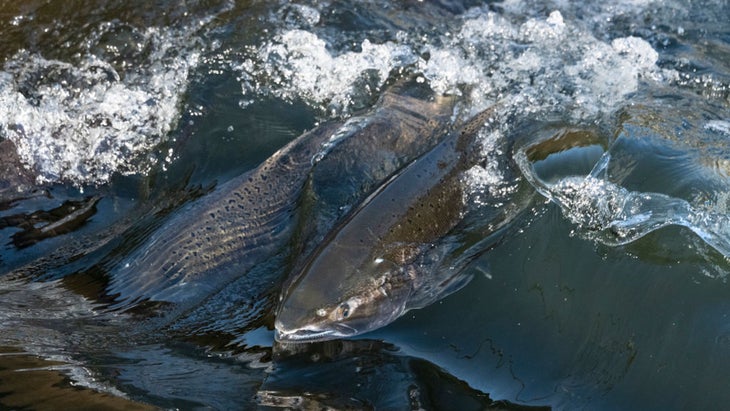The governor’s hatchery plan ignores the science—and the wild fish, according to Yvon Chouinard, Patagonia’s founder, and Matt Stoecker, a California farmer and fisheries ecologist
Left: Yvon Chouinard; right: Gavin Newsom (Photo: Al Seib/Getty, Allen J. Schaben/Getty)
Published August 21, 2025 04:51PM
In May, California Governor Gavin Newsom announced upgrades to 21 state-run fish hatcheries and truck salmon around dams in an effort to increase salmon populations. But Newsom’s plans are misguided and misleading.
These schemes would waste our tax dollars on ineffective and never-ending boondoggles that fail to solve the destructive impacts of dams on our fisheries and watersheds. Hatcheries harm endangered California salmon without addressing a major cause of their decline: migration-blocking dams that degrade our treasured watersheds.
These hatcheries and their derelict relative, trap-and-truck, which are also promoted by Newsom, require carbon-intensive facilities, diesel-powered fish “migration,” and billions in tax dollars to keep stumbling along indefinitely. No amount of upgrades can retrofit an entirely misguided concept. Advertising them to the taxpayer as climate resiliency measures is disingenuous.
These backward directives will use your money to dump another $1 billion into programs that, contrary to what proponents say, will not lead to salmon recovery and will compromise climate commitments.

Just ask hatchery and trap-and-truck promoters if these programs will lead to wild fish “recovery.” They can’t, because by definition, hatcheries and trucking fish do the opposite. They require endless human intervention. This model will never achieve “wild, self-sustaining” salmon populations, as required by the Endangered Species Act, to achieve recovery and delisting.
When hatchery salmon are released into our waters, they suffocate their wild counterparts with sheer numbers, weaken the gene pool, spread disease, and increase predation. A 2019 report, based on 50 years of data and published in the journal Fisheries, found that 83 percent of salmon hatcheries caused adverse effects on local wild populations. Another study, published in the Environmental Biology of Fishes, found that wild juvenile Chinook salmon have a survival rate of between 7 and 31 percent. Hatchery salmon came in at 1.3 percent. An analysis from the Columbia River found the cost to citizens to harvest a single hatchery Chinook salmon was $68,031. Wild salmon do it for free.
California’s own Steelhead Restoration and Management Plan makes a timely point: “There is a risk that operation of an artificial production facility [hatchery] to rebuild a depleted population … can mask the real problems and delay implementation of long-term solutions.” Artificial truck migrations do the same.
What we said ten years ago rings just as true today: recovered wild fish don’t ride in trucks—and they aren’t born in plastic mixing bowls at hatcheries either.
There is a proven way to solve the problem, and Newsom should know it: restore unassisted fish migration to natural habitats they’ve been blocked from by removing dams in favor of more climate-resilient water and energy solutions.
We can see the benefits of this action happening now in Northern California and Southern Oregon. On the Klamath River, thousands of Chinook salmon regained access to 400 miles of habitat after four dams were removed. Toxic algae blooms that plagued the former reservoirs have been replaced with a cleaner, free-flowing river.
Removing dams will also help us transition to smarter water storage solutions. River Partners project at Dos Rios is showing us a better way to capture stormwater on expanded floodplains that can still be farmed, provide wildlife habitat, safeguard communities, and recharge our depleted groundwater aquifers.
Some say removing dams is crazy. What’s actually crazy is our water agency’s lack of foresight to count on inefficient dams in a changed climate: According to one study of 721 dams in the U.S., their reservoirs lost the equivalent of 93 percent of the annual U.S. public water supply through evaporation. California’s own Department of Water Resources estimates our depleted groundwater basin storage capacity is over 17 times greater than all the major reservoirs in California combined. Storing water underground eliminates evaporation waste and persistent reservoir storage loss to sedimentation.
Some state leaders are falsely touting hydropower as “clean energy” when the science clearly shows dams and their methane-emitting reservoirs are huge climate culprits. Dam removal eliminates this ignored emission source while restoring massive carbon sinks as these reservoir areas regrow into productive forests, grasslands, and forgotten farmlands. Legendary investor Warren Buffett owned those removed Klamath dams. PG&E is wisely throwing in the towel on its Eel River dam disasters. Are these business leaders crazy to get rid of these dam liabilities? Or are California leaders crazy to double down with our tax dollars on degrading dams and welfare salmon smokescreens?
Fortunately, Newsom did come around to supporting the recent privately owned dam removal efforts. But what about the many California dams that we, the public, own? Why should we shoulder the financial burden to upkeep deadbeat dams when less expensive and more reliable solutions exist? Does Newsom want his legacy to be generations of Californians financing a future of decaying dams, receding reservoirs, Mack truck migrations, and hatchery hubris? With ambitions past the Governorship, this is an opportunity for Newsom to show his leadership on a key national issue. We need a leader to move us toward truly climate-resilient and safe water supplies, low-carbon energy alternatives, self-sustaining wild fisheries, and reduced tax burden for generations to come.
Yvon Chouinard is the founder of California-based outdoor apparel company Patagonia.
Matt Stoecker is a California farmer and fisheries ecologist.


